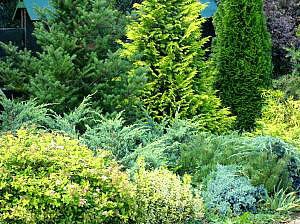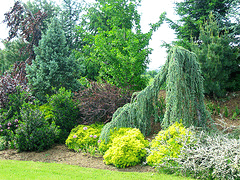Using Shrubs in the Gardens and Landscape
With nearly unlimited variety of size, shape and color, shrubs are an excellent way to anchor your garden with a defining background, as well as your homes foundation. Carefully selected, they can provide color, interest and height to your gardens, soften corners, "ground" your homes foundation, or create barriers and screens. Even in winter, when summer plants have ceased to exist, the woody stems and branches of deciduous shrubs continue to define your garden spaces. Consider shrubs with interesting or unusual growing habits, perhaps weeping or arched branches, to create interest in your landscape both summer and winter.
Smaller shrubs are generally chosen for foundation plantings, partly because of limited space. But there is no limit to the shrubs that can be used as a foundation planting. Larger shrubs can certainly be used around your foundation as long as you plan enough space for them, and do not plant too close to the structure. Many of the small flowering shrubs begin their bloom early and last all summer, which is also important aesthetically for the foundation of your home where you may not have room for annuals or perennials. Such shrubs are also excellent as a border to other landscaped areas of your lawn that do not include flower beds.
Larger shrubs, 4 to 6 feet, are better suited to corners of a foundation or lawn, or further back in a garden bed providing a backdrop of interesting texture or dramatic color. Even larger shrubs, 6 feet or taller, are best used for privacy or screening. The tall shrubs can also provide some shade to a too sunny spot, or act as a windbreak. Remember that when they reach mature height, you will not be able to easily trim and prune.
And hardy shrubs are a busy gardener's dream, requiring much less maintenance than annuals and perennials, but returning year after year to enhance your landscape. A hardy shrub is much more resistant to drought and pests than herbaceous plants. Native species are always a good choice, since you already know they thrive in your climate region. Do be sure you are choosing a native to YOUR geographic region, not just a North American Native. For example plants that are native to the North Eastern coast may be zone 4, 5, or 6 hardy, but soil and moisture conditions are nothing like the midwest zones 4, 5 and 6. Also be aware of species declared invasive for your region. Such common varieties as Butterfly Bush, Japanese Barberry and Privet have been declared invasive in some areas.
Just like annuals and perennials, zone hardiness as well as the "micro-climate" of the planting site must be considered. Shrubs (and trees) grown in perfectly ideal conditions will become larger than one grown in less than ideal conditions. In full sun they will often grow fuller and wider, but perhaps not so tall. If crowded among trees and larger shrubs, it may be sparsely branched and stretch very tall to reach more sunlight.
Many specific site conditions can affect the health and growth of your shrubs. Before selecting a plant, consider the specific spot you intend to plant it. Is it moist or dry shade? Windy or sheltered? Morning or afternoon sun? And sometimes important, will the shrub hold up to abuse by children, dogs, deer or rabbits?


